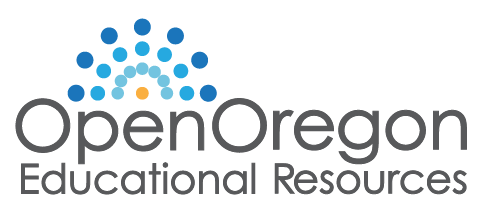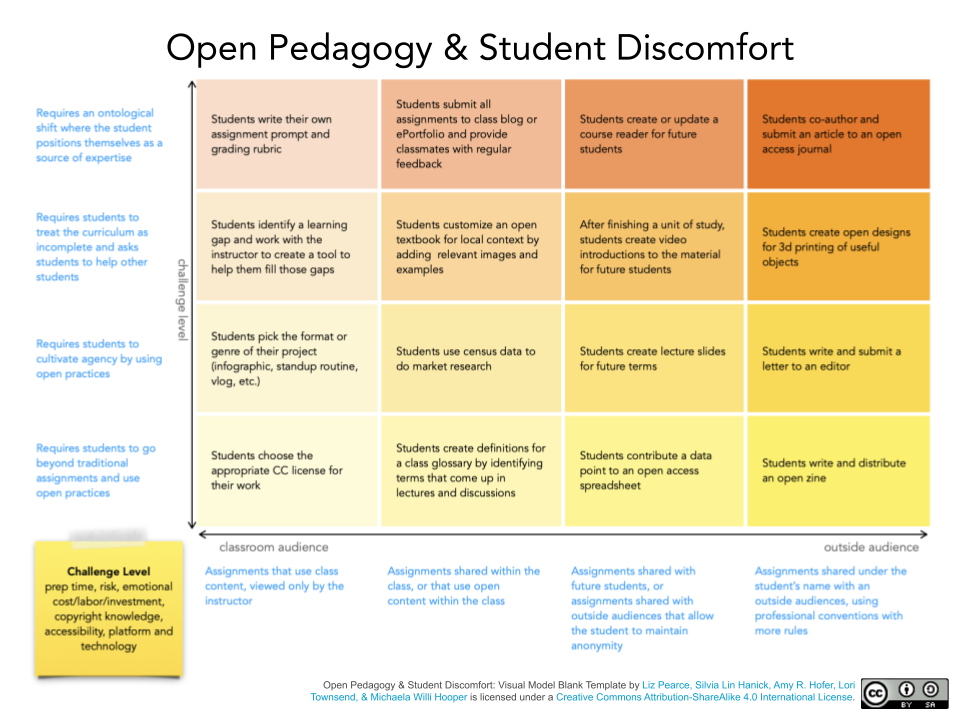This post was contributed by Liz Pearce, Department Chair, Education/Human Development and Family Sciences, Linn-Benton Community College; Silvia Lin Hanick, Acting Chief Librarian, LaGuardia Community College (CUNY); Amy Hofer, Statewide Open Education Program Director, Open Oregon Educational Resources; Lori Townsend, Learning Services Coordinator and Social Sciences Librarian, University of New Mexico; and Michaela Willi Hooper, OER Consultant.
This writing project began with Liz’s reflection on her first dive into teaching with open pedagogy in which students contributed to the open textbook Contemporary Families: An Equity Lens (currently under revision for a second edition). Along with exhilaration and a sense of purpose, students experienced emotional pain, feelings of inadequacy, and vulnerability. In order to learn from the experience, Liz started a conversation with Michaela, then the OER librarian at her college, which grew to include Amy, Oregon’s statewide OER program director, then Lori and Silvia, both librarians with teaching and learning expertise. With the various backgrounds that the group brought to this discussion, there was a shared insight that emotional reactions to participation in open pedagogy assignments aren’t necessarily bad, but that perhaps there are ways to anticipate and prepare students for the affective impacts of deep learning.
We define open pedagogy as a practice in which students are creators of openly licensed content for a real-world audience. This definition is informed by the work of David Wiley, Robin DeRosa, and Rajiv Jhangiani.
Learn more about our work:
- Your Discomfort Is Valid: Big Feelings and Open Pedagogy. Peer-reviewed article published in Knowledge Cultures
- Your Discomfort Is Valid: Big Feelings and Open Pedagogy. Full text article preprint shared in CUNY Academic Works
- Your Discomfort is Valid: Supporting Big Feelings in Open Pedagogy. Recorded presentation at 2021 Open Education Network Summit
- Using Open Education Instructional Design to Transform the Classroom and the Community. Recorded presentation at 2022 Open Education Conference with Liz Pearce; Veronica Vold, Open Oregon Educational Resources; and Kim Puttman, Oregon Coast Community College
Visual Model
Our group developed a visual model, designed by Silvia, in order to explore our ideas about how open educators can raise or lower the stakes of an open pedagogy assignment. We suggest thinking about the model as a tool for scaffolding assignments – for example, you might not assign work with the highest challenge level for the most public audience (upper right corner of the model) if your students aren’t prepared by first testing the waters with lower-stakes work. The model supports flexible approaches that allow students to opt out of components of the assignment that are causing unproductive discomfort, such as content areas, privacy settings, letter grades, emotional work, public sharing, or open licenses. Where instructors observe students getting stuck, the model may suggest a shift to something different that’s within the zone of proximal development but not triggering.
Here’s our caveat: “All models are wrong, but some are useful” (attributed to George Box). Even though we’re presenting a visual model that is shaped like a grid and borrows x and y axes from math, our intention is not to imply precision. Consider the model as a gradient – not a chart – that explores relationships. Our hope is that this model will provide you with a starting point for scaffolding the affective dimensions of your open educational practices.
We populated each cell of the gradient with an example assignment representing the corresponding challenge level and audience type, but we expect that our model will need to be edited or even redrawn depending on your situation, so we also created a blank version with a word bank. The word bank provides examples of open practices that you can use to fill out the blank visual model template based on your personal, or institutional, challenges, or you can add other open practices of your choosing. For example, your students may see technology as less of a challenge than we expect it to be. Or, your discipline may work with materials, like proprietary datasets, with more complex copyright considerations than our model can address.
Challenge level can represent the time you have to prepare for a new assignment, the emotional labor required to responsibly support student work in the open, accessibility concerns, or familiarity with a new platform. We can suggest in general that assessments requiring high support for students will present a high challenge level for the instructor; the more open things get, the higher the challenge level because the instructor needs to provide more support.
Our colleague Kim Puttman, Adult Basic Skills and Sociology Faculty, Oregon Coast Community College, tested out the visual model and told us:
The open pedagogy model helped me to implement open pedagogy for the first time in my classroom. It helps resolve a tension in open pedagogy: while open pedagogy empowers students, it also requires students to take risks because their work could be seen outside the boundaries of a classroom. This model offers practical ideas for engaging students at the level of work and the level of openness they are ready for. It helped me to understand student-centered work in a new way, and meet my students where they are more gracefully.
This figure can be accessed via Google Slides, Google Drawing, or Open Pedagogy & Student Discomfort Visual Model for Screen Readers.
| Word Bank for Blank Visual Model Template |
|
Strategies for handling discomfort
While we were working on the affective dimensions of open pedagogy in general, we focused in particular on strategies to anticipate and mitigate feelings of discomfort. Discomfort about working in the open can come from many sources. To offer an incomplete list of possible worries: having novice work held to a higher standard of accountability by a public audience, having to fail where everyone can see you fail, publishing something permanent even though it is not perfect, improperly citing a source and getting in trouble, offending people when talking about race, or trying to solve big -isms. Such concerns are valid. The possibility of student work being shared publicly also raises considerations about future negative repercussions and student privacy that should be balanced against benefits such as a coauthor line on a CV or experience handling feedback from experts.
It’s important for students to know that discomfort itself is not a goal of learning, nor is it always a signal of productive learning. Sometimes discomfort is the result of revisiting trauma or the experience of managing ongoing external threats. The work of Taylor and Baker recommends that instructors should carefully consider what learning outcomes will justify student discomfort and whether that experience will be disproportionately distributed across students of varying backgrounds.
We propose strategies that center the instructor’s agency by suggesting ways to minimize unproductive discomfort. Since students may have very different internal reactions, they also need ways to provide input and customize the experience to their needs. Just like with research studies, student participants in open pedagogy should be able to opt out of sharing their identity and work right up to the point that they add a Creative Commons license to their contribution.
Cocreating Frameworks that Balance Structure with Flexibility
First, we recommend practices that balance scaffolding and structured course design with flexibility as a way to provide students with emotional support. Here are a few examples:
- Students write individual learning plans (see Liz’s example in Appendix A of our article) as their first assignment.
- Instructor provides alternate assignments (for example, visualizing data; writing definitions or test questions) if the original plan needs adjustment.
- Instructor accounts for ways that new and existing teaching strategies will affect their workload.
Course redesign itself can be incremental or scaffolded. Open education doesn’t require enormous change all at once; course redesign should not lead to unsustainable labor practices for faculty.
Cultivating a Practice of Self Awareness and Care
Second, we recommend prioritizing self awareness and care (for yourself and others) to mitigate potential student discomfort in open education settings. This includes consideration of the varying degrees of privilege or minoritization that students bring to the course. Here are a few examples:
- Cultural humility can inform how instructors respond to students’ feelings of doubt, uncertainty, or inadequacy, helping them more accurately assess and own their expertise and the value of their contribution as a voice currently missing from the discourse. At the same time, accurate self-perception grounds the instructor in the expertise that they bring. Cultural humility takes positionality into consideration in order not to be reductive about power dynamics.
- Metacognitive skills can help students self-regulate and observe their affect and cognition through strategies like journaling and exit tickets. Asking students metacognitive questions encourages engagement, growth mindset, and reflection on potential support options (e.g., Why are they doing this? What strengths, weaknesses, and skills do they bring? What are they afraid of and worried about?).
- Care for self and care for others balances critical self-reflection for students and for faculty who are engaged in open pedagogy and transformative learning. An instructor can always take the important step of connecting students with campus mental health resources and both discussing and modeling self-care.
Crowdsourcing Solutions from OER Communities
Last, we highly recommend reaching out to your campus resources and open education communities when questions come up. This itself is an example of working in the open and can elicit thoughtful and empathetic feedback from others interested in open pedagogy. The beauty of open education is that open educators are predisposed to work collaboratively, transparently, and cross-institutionally.

